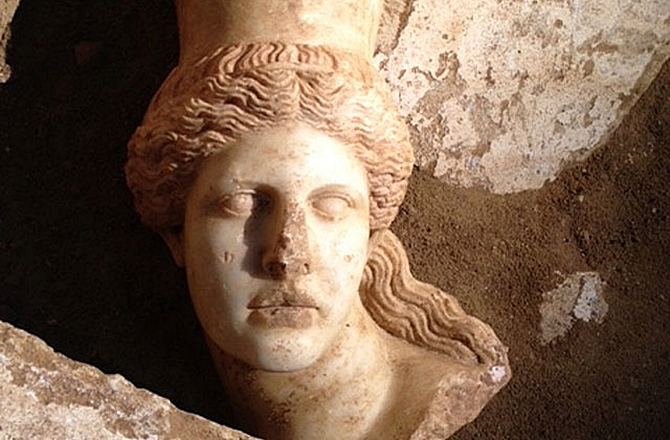
© Greek Ministry of CultureThe newly found head of the sphinx.
Greek archaeologists made another amazing find on Tuesday as they unearthed the missing head of one of the two wingless sphinxes guarding the large and mysterious burial site in Amphipolis, in Greece's northeastern Macedonia region.
According to a statement by the Culture Ministry, the finely carved head was found inside the tomb's third chamber. Fragments of the wings were also unearthed.
About 24 inches high, the marble head depicts a beautiful woman who appears to smile slightly. Apart from some minor damage to the nose and lips, the sculpture is largely intact.
The life-like work features curls falling on the left shoulder and tied around the head with a thin band. There are traces of a reddish color in the hair.
"This is a sculpture of magnificent art," the culture ministry said.
The ministry added that a clean break at the bottom of the neck shows a perfect fit with the eastern sphinx.
Weighting about 1.5 tons and bearing traces of red coloring on their feet, the colossal sphinxes were found in August. Archaeologists led by Katerina Peristeri believe the mythological statues were meant to guard the burial, which is the largest tomb ever uncovered in Greece.
The tomb has been dated to the last quarter of the fourth century B.C. (325-300 B.C.), the period immediately following the death of Alexander the Great in 323 B.C.
Among the most interesting features discovered by Peristeri's team are two carved caryatids - female figures that serve as architectural support - and a large mosaic depicting the abduction of Persephone by Pluto.
Amazingly, such features are represented in the marble throne found in the royal cemetery at Aegae (modern Vergina) in the tomb attributed to Eurydice I, the grandmother of Alexander the Great.
The throne features the scene of the abduction of Persephone by Pluto as well as carved caryatids and sphinxes in its panel decorations.
The now almost totally reconstructed eastern sphinx strongly resembles the sphinxes on the throne. Unfortunately, the decorations were stolen from the royal seat in 2001.
The archaeologists also unearthed the northern section of the marble threshold, which is seven feet long and more than five wide and features indents that once held metal rails. These were meant to ease the movement of the heavy marble door.
The western wing of the door was also found, broken in two pieces.
Why the head of the sphinx was found inside the tomb's third chamber remains a mystery. It is quite unlikely looters would bother to move the marble sculpture from the tomb entrance into its interior.
The fragmented marble door also poses questions.
"Why is the door at Amphipolis so much more damaged than the rest of the structure and sculpture ... was it locked?," Dorothy King, a classical archaeologist not involved in the excavation,
wrote in her blog.
"If so this would be the first evidence of a possible attempt to rob the tomb in antiquity. Or maybe the slabs were less secure than the rest of the building, so they fell and shattered," King said.
According to the scholar, all the evidence so far made available suggests that there were structural issues with the tomb due to the huge weight of the mound bearing down on it.
She suggests there was a first attempt to use scaffolding to support the roof. In this view, the large hole in the mosaic center could be caused by a post used to support the beam above.
"My current working hypothesis is that they filled the structure with soil to try to stop it collapsing, and then attempted to remove some of the superstructure to reduce the weight on the chambers," King told Discovery News.
"The way the blocks cracked all suggests that the stress came from above and not from below as would be more usual in an earthquake," King said.
Reader Comments
to our Newsletter